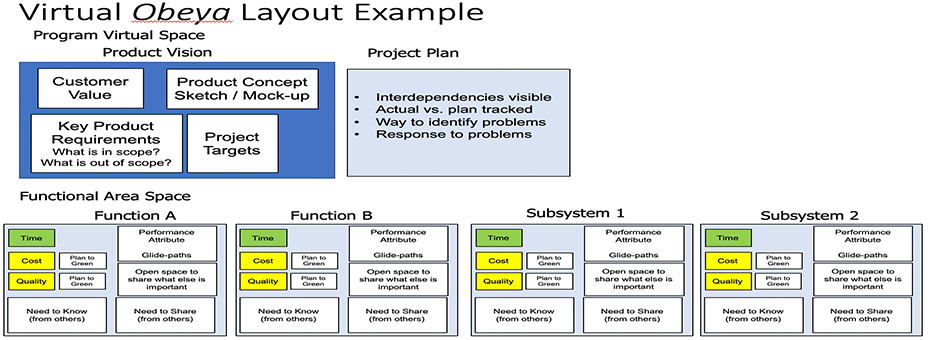As we are adjusting to new ways of working for as many people as possible through social distancing to slow the spread of COVID-19, we have to find new ways to work together effectively. Lean processes and tools are designed to enable people to work effectively together to solve a problem or achieve a purpose. So, it is an excellent approach to use as we take on these new challenges ahead of us. One aspect of lean is creating our processes and adapting technology to support those processes rather than letting technology define our processes. When abruptly changing how we work together, it can be easy to let technology influence the way we work. It is worth taking some time to reflect on the purpose of our processes and tools and how we are using technology to support our objectives.
Let’s take obeya as an example. It is a commonly used lean product and process development tool that people have had a lot of interest in doing remotely for a long time. With obeyas, we are trying to create conditions for teams to effectively work together to make decisions and solve problems.
The big-picture purpose of obeya is to enable people to work together effectively. From behavioral economics research, we know that for creative workers to achieve better performance and personal satisfaction, they need to be motivated intrinsically, which Daniel Pink describes in his 2011 book Drive. This includes having autonomy with some sense of ownership over your work, mastery to always be improving your skills, and purpose. Focusing on purpose is even more critical now as we navigate through this pandemic. Another framework that is helpful to support an enabling system is Carol Dweck’s work on growth vs. fixed mindset. Both of these frameworks are helpful to think through as you are using lean tools to consider if you are using them in ways that support a growth mindset and are providing autonomy, mastery, and purpose. Not every tool needs to do everything, but collectively people need all the pieces, and obeya can provide it all. We need to be mindful of what our behaviors are and do they support creating an enabling environment for people to work together effectively.
At the program level, the typical objectives people are trying to achieve through obeya include:
- Making decisions relatively quickly with technical experts discussing trade-offs.
- Getting team alignment on what the product needs to be.
- Enabling cross-functional integration and collaboration.
- Identifying problems early.
- Facilitating cross-functional problem solving.
This starts with understanding the work visually. This shared understanding of the work needs to include how everyone’s work fits together including interdependencies. Common things to make visual in an obeya to facilitate shared understanding include:
- Product vision – Translate the concept paper to the wall / virtual space.
- Performance attributes with glide paths to achieve.
- Project schedule with the ability to see problems early.
- Leading metrics.
- Areas of the room / virtual space that each function owns to create opportunities for ownership and autonomy.
- Information each function thinks is important to share – How does your work fit together?
- Knowledge gaps and plans to close.
- Concept sketches / product mockups.
Not all of these pieces should be visible throughout the duration of the project. As the work changes through the different phases of development, what is visual should change. What is visual should be what is essential for the project at that point in time. At a glance, you should know what is important, and the whole team should agree on what is important, which is why we make it visual, so we can all see and understand together. How can you make the work visual virtually?
You made things visual, but how does that impact how the work is done?
- Are people only in the obeya (virtual obeya space) during the cadenced obeya meetings?
- The intent is that obeya is the space to collaborate with the knowledge you need available.
- Are you able to effectively “manage by exception,” where you only talk about things that are not on track?
- Does it enable cross-function problem-solving?
- What cross-functional learning opportunities are emerging?
- In the obeya meetings having the chief engineer or program manager “walk the walls” can enable each function / section leader take greater ownership and provide leadership opportunities.
- Seeing what people share in “their section” of the room enables engagement to be seen and where that person is in their understanding of their work and how it fits together. This also creates coaching opportunities.
What is the management system you are using in obeya?
A management system = leadership behaviors X operating system.
An obeya management system includes:
- Tracking actual vs. plan.
- Identifying problems – when actual deviates from the plan.
- Effectively communicating problems.
- Effectively responding to and solving problems.
Effective is a keyword in that description. Sometimes we think we are communicating a problem or helping with a problem, but we aren’t doing so effectively. One failure mode with responding to problems happens when the only help you are providing is asking for more reports about the problem, which isn’t helpful, and you are unlikely to have problems identified going forward.
Some common failure modes to be on the lookout for in obeya are:
- Everything is green (There are never problems identified).
- Red is the new normal, with no plans to green (It is ok to identify a problem, but ok not to solve it).
- Andons (asking for help on a problem) are not responded to.
- There is a lack of clarity on what is important on the program.
- Information is not updated.
- Room / virtual meeting space is only used / looked at for meetings.
- The only thing visual is the project schedule.
- People are doing other things during the meeting.
- Used in a way to control people instead of enabling them.
Tips to consider for using obeya effectively:
- Keep things simple – Make it clear and easy to interpret.
- Information that is shared to think about:
- What do I need to share with others? You know your work better than anyone else. From your perspective what do others need?
- What information do I need from others? People don’t always know what you need. Be sure to ask.
- Display data in a way so that you can see abnormal from normal.
- Make the product visual – mock-ups, renderings, drawings, CAD models, etc.
- Track leading metrics to see issues sooner.
- Use glide paths for product targets.
- Have an andon in place to flag issues and ask for help.
- Adjust the information and visuals to fit everyone’s needs as the program evolves.
- Reflect on what is working / not working on a regular cadence.
- Including the people aspects of coaching for a growth mindset and providing opportunities for autonomy, mastery, and purpose.
As we are working socially distanced apart, we need to create systems that enable us to effectively help people to collaborate together to solve problems. How are we and how can we use technology to support collaboration? Do you have lessons learned to share on effectively working together remotely through this pandemic?
Designing the Future
An Introduction to Lean Product and Process Development.






